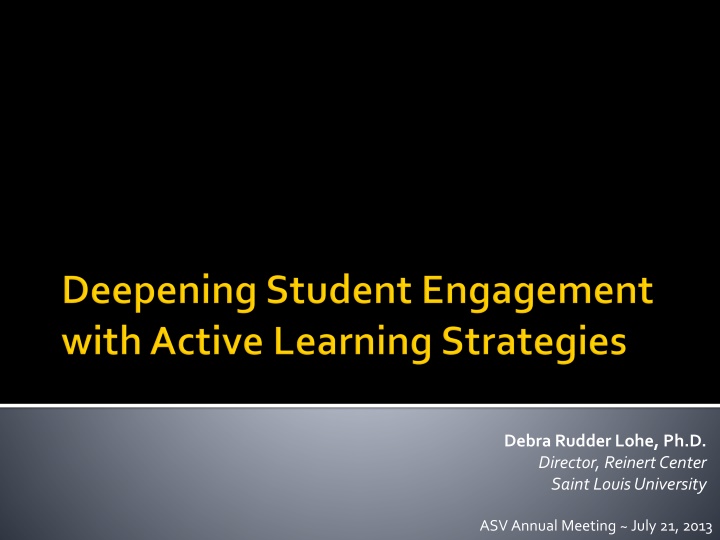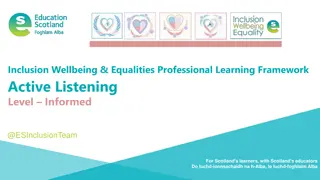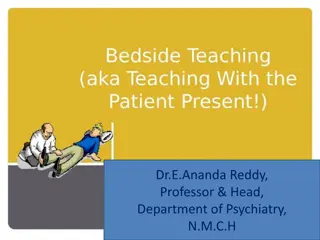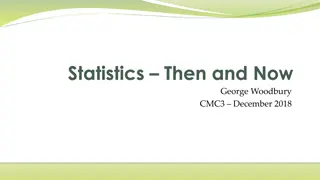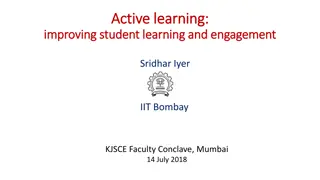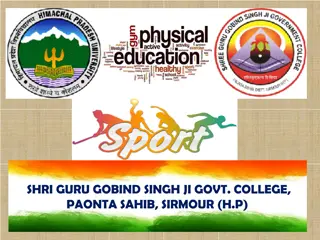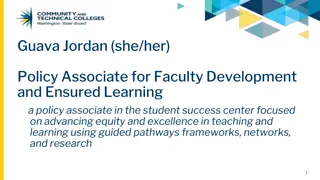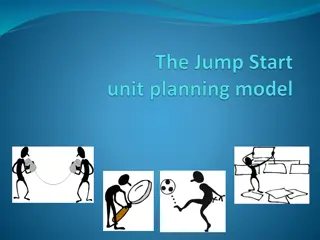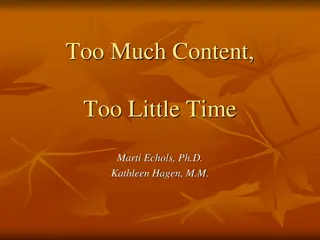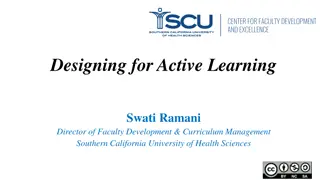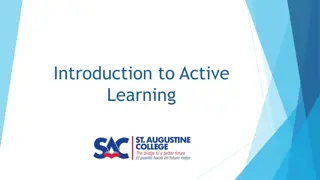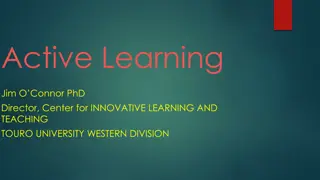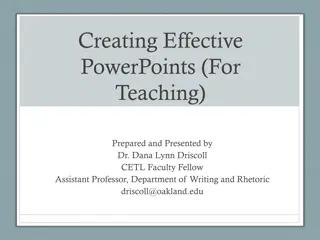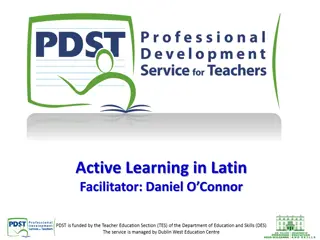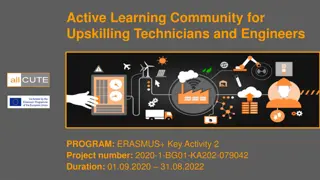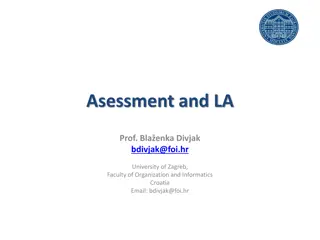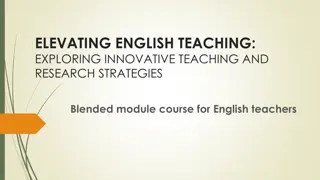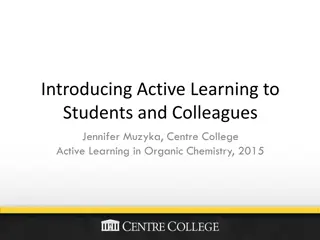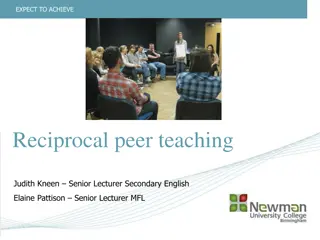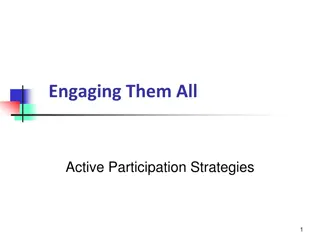Enhancing Teaching through Active Learning Strategies
Explore various active learning strategies to engage students effectively, make informed decisions on techniques suitable for your teaching context, and align strategies with learning goals for enhanced student outcomes. Embrace the importance of interactive teaching methods for deep learning experiences.
Download Presentation

Please find below an Image/Link to download the presentation.
The content on the website is provided AS IS for your information and personal use only. It may not be sold, licensed, or shared on other websites without obtaining consent from the author.If you encounter any issues during the download, it is possible that the publisher has removed the file from their server.
You are allowed to download the files provided on this website for personal or commercial use, subject to the condition that they are used lawfully. All files are the property of their respective owners.
The content on the website is provided AS IS for your information and personal use only. It may not be sold, licensed, or shared on other websites without obtaining consent from the author.
E N D
Presentation Transcript
Debra Rudder Lohe, Ph.D. Director, Reinert Center Saint Louis University ASV Annual Meeting ~ July 21, 2013
Examining Assumptions Yours, Mine, Ours Understanding Active Learning What, Why, How Making Choices Goals, Objectives, Philosophies
This session will . . . Introduce a range of active learning strategies appropriate for varying types and sizes of classes Provide examples of small, interactive lecture techniques for efficient student engagement Prepare you to make decisions about active learning techniques appropriate for your context I.e., make you do stuff! Model active learning strategies
After this session you should be able to . . . Identify a range of active learning strategies appropriate for your own teaching situation Explain why interactive techniques are important for learning Connect specific active learning strategies with your goals for student learning and engagement
You care about teaching You may not have been taught how to teach You re busy! And you ve got coverage issues You want deeper learning from students Think like a virologist vs. Regurgitate stuff I tell you Students sometimes frustrate you And you sometimes frustrate them!
There is a lot of content to cover And it s growing all the time? The signature pedagogy is lecture Maybe with some discussion of primary literature It happens in a lot of different contexts Graduate, undergraduate, and medical Small classes and large ones Labs, clinics, and other non-classroom learning spaces
So . . . what assumptions do you make about active learning ?
Learning is active Students learn more (and more deeply) when they re engaged Lots of things constitute active learning and you may already be doing some of them Even very small active learning exercises can make a difference Active learning strategies can be applied in any size/type class
anything that students do in the classroom other than merely passively listening to an instructor s lecture (Paulson & Faust) Active Learning activities are instructional activities involving students in doing things and thinking about what they re doing (Bonwell & Eison) Active learning means that the mind is actively engaged. Its defining characteristics are that students are dynamic participants in their learning and that they are reflecting on and monitoring both the processes and the results of their learning. (Barkley) The core elements of active learning are student activity and engagementin the learning process. (Prince) It s an approach, not a specific method.
The Why: What do cognitive psychologists say? . . . active learning involves the development of cognition, which is achieved by acquiring organized knowledge structures and strategies for remembering, understanding, and solving problems . . . . active learning entails a process of interpretation, whereby new knowledge is related to prior knowledge and stored in a manner that emphasizes the elaborated meaning of these relationships. So, for cognitive psychology, this means doing 3 key things: Activating Prior Knowledge Chunking Practicing Meta-cognitive Awareness 1. 2. 3. Suzanne M. Swiderski Active Learning: A Perspective from Cognitive Psychology (2010)
Ambrose et al. Students prior knowledge helps / hinders new learning How they organize knowledge influences how they learn and apply what they know. Motivation determines, directs, and sustains what they do to learn. To develop mastery, students must acquire component skills, practice integrating them, and know when to apply what they have learned. Goal-directed practice, coupled with targeted feedback, enhances the quality of learning. Students current level of development interacts with the social, emotional, and intellectual climate of the course to impact learning. To become self-directed learners, students must learn to monitor and adjust their approaches to learning. 1. 2. 3. 4. 5. 6. 7.
Ambrose et al. Students prior knowledge helps / hinders new learning How they organize knowledge influences how they learn and apply what they know. Motivation determines, directs, and sustains what they do to learn. To develop mastery, students must acquire component skills, practiceintegrating them, and know when to apply what they have learned. Goal-directed practice, coupled with targeted feedback, enhances the quality of learning. Students current level of development interacts with the social, emotional, and intellectual climate of the course to impact learning. To become self-directed learners, students must learn to monitor and adjust their approaches to learning. 1. 2. 3. 4. 5. 6. 7.
The Why: Average Retention Rate from Different Teaching Methods (% of learning students can recall after 24 hours) 2% 4% 7% 11% Demonstration 18% Discussion Group 27% Practice by Doing 31% Teach Others Immediate Use of Learning Lecture Reading Audiovisual Cited in Barkley, Student Engagement Techniques David A. Sousa How the Brain Learns (2000)
The Why: Average Retention Rate from Different Teaching Methods (% of learning students can recall after 24 hours) 2% 4% 7% 11% Demonstration 18% Discussion Group 27% Practice by Doing 31% Teach Others Immediate Use of Learning Lecture Reading Audiovisual verbal processing verbal + visual processing doing / applying Cited in Barkley, Student Engagement Techniques David A. Sousa How the Brain Learns (2000)
We want the so-called higher-order cognitive skills, not just repetition and regurgitation ( la Bloom) Achieving higher levels of thinking requires students to do something, to engage actively in the learning process. Also, students learn best when they re aware of where they are on this pyramid (meta-cognitive). Sitting passively in class won t promote higher-order thinking. Neither will activities that only ask for remembering & understanding. (Caution: misalignment)
The How: What active learning strategies do you already use?
Interactive Lectures Problem-Based Learning Case-Based Learning Other Inquiry-Guided Learning Service-Learning Collaborative and Cooperative Learning
Interactive Lectures Problem-Based Learning Case-Based Learning Other Inquiry-Guided Learning Service-Learning Collaborative and Cooperative Learning
Feedback Lecture One-Minute Papers Guided Lecture Think / Pair / Share Responsive Lecture Other: Discussion Mini-Cases Flipped Classroom Pause Procedure Lecture Quiz ConcepTests
Class size and/or type Time (or lack of it!) Student perceptions, motivation Faculty perceptions, lack of knowledge Content tyranny (Prince 2004)
Start with course goals and your student learning objectives for each lecture / lesson. What s the difference? Consider your teaching situation. Reflect on your teaching philosophy and teaching style.
Start small a little goes a long way, and you need different things at different times Consider whether you really are losing something for content Podcast lectures, have students doing things in class Begin to let students help prepare / teach / model / demonstrate things in class
Provide rationale (so students know why) Give them a little research on learning Introduce Bloom; use to structure exams Set expectation from the first day Ask students to devise or propose activities
List all the concepts, ideas, points you can recall from this session. 1. Identify the most important idea for your teaching. 2. Describe / define why it s important for you / your courses. 3. Elaborate new questions it raises / calls to mind. 4. Apply the concept: how would you use it in class? IDEA activity adapted from Feb 2010 issue of National Teaching and Learning Forum.
Debie Lohe dlohe@slu.edu
BLOOM (1956) ANDERSON & KRATHWOHL (2001) Revised version of Bloom's Taxonomy pyramid. Original version of Bloom's Taxonomy pyramid. http://www.learnnc.org/lp/pages/4719
COURSE GOALS LEARNING OBJECTIVES General, broad Specific, concrete About you/course About students State what you or the course will do / teach State what students will know and/or be able to do Describe hopes & ideals for student learning Describe observable, measurable actions May describe kind of learning experience Can be cognitive, affective, or psychomotor
Subject Class Teacher Learner
Expert Formal Authority Delegator Personal Model Facilitator Anthony F. Grasha, Teaching with Style (1996)
